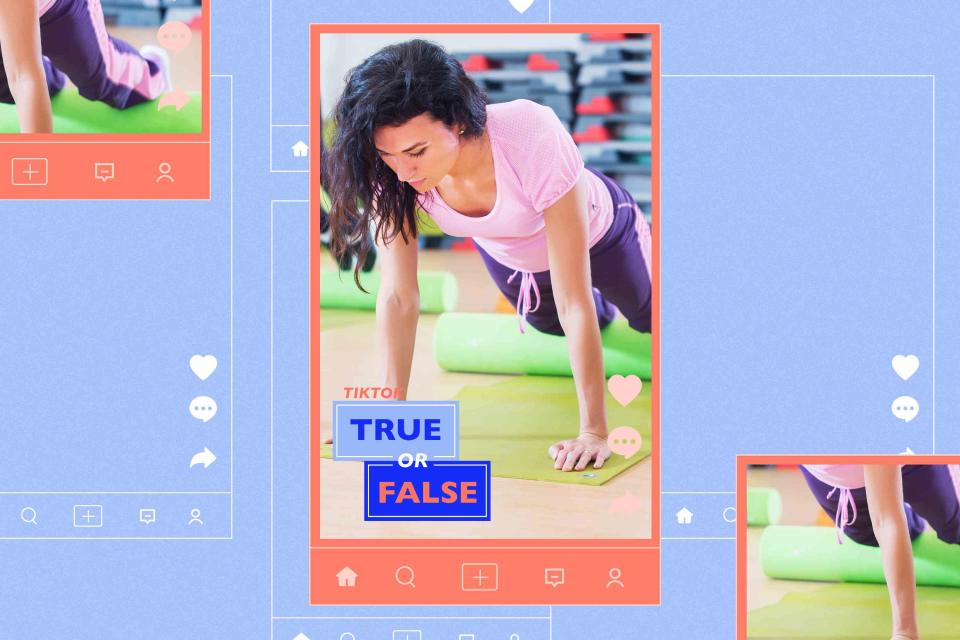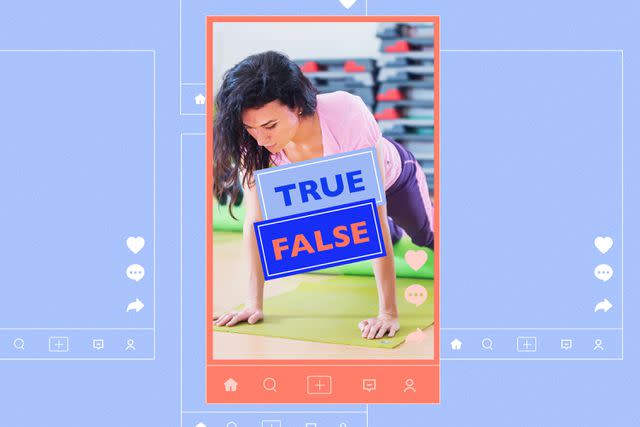TikTokers Are Using Foam Rollers to Do Pilates at Home Without a Reformer
- Oops!Something went wrong.Please try again later.
Find out if this really is a good alternative to buying an expensive reformer machine or paying for in-studio classes.

TikTok True or False is the answer to your burning questions about the health, beauty, and fitness fads taking over your social feeds. Each story breaks down a buzzy wellness trend with the help of experts and scientific research to uncover the truth and safety behind the viral "advice" you see online. You'll never have to wonder what's actually legit — or what to skip — again.
Pilates regularly gets props for being an effective low-impact workout, but it's not cheap. Traditionally, you need to shell out serious cash for in-person reformer Pilates classes or invest in a pricey reformer machine, which typically retails for $1,000 or more to have at home.
So, leave it to people on TikTok to find a hack for doing Pilates for much, much less money. While practitioners have always been able to do mat Pilates at home with just a yoga mat and perhaps a YouTube video, clips are popping up on TikTok showing people using foam rollers to mimic Pilates reformer movements at home.
:
One person doing this is TikTok user Amanda Blauer, who has an online Pilates studio called Amanda Blauer Pilates. Blauer has posted several videos on TikTok of her doing a range of traditional reformer moves, including inverted Vs, planks, and rolling bridges with just a foam roller and a mat. "When your lower body is 10x stronger doing mat Pilates with props after 2+ years than it ever was using the reformer 2x a week," she wrote in text over one clip.
Other Pilates instructors have shared similar videos on TikTok. User Talia Savva of Soma Pilates has posted a variety of clips of herself performing Pilates moves on a reformer, then cutting to her on a mat with a foam roller mimicking the same types of movements. So have Kaylie Daniels of the Glow Method, Hayley Sullivan of ID Pilates, and more TikTokers.
If you're a fan of reformer Pilates but not willing to spend a fortune on in-studio classes or a home machine, this TikTok hack sounds like a great alternative. But is this exercise method legitimate? Can you get a reformer Pilates-quality workout at home using just a foam roller and a mat? Ahead, Pilates instructors weigh in on the latest workout trend.
What is reformer Pilates?
Backing up a moment: Pilates is a type of exercise developed by Joseph Pilates in the early 20th century. It was originally designed as a form of exercise to help injured dancers recover, but it eventually became a more all-encompassing workout to strengthen muscles with a focus on the core and intentional breathing, per the Cleveland Clinic. ICYDK, it's still wildly popular, with many celebrities raving about the classic workout method.
:
If you step into a Pilates studio today, you'll likely be greeted with a row of Pilates reformer machines. A Pilates reformer is a machine that has a flat, cushioned, moving carriage with shoulder blocks. It has a back and front platform at either end of the machine. The front platform typically has springs used for resistance and the back platform usually has two adjustable bars.
"The reformer is a traditional piece of Pilates equipment that was created by Joseph Pilates, the founder of Pilates," says Robin Long, certified Pilates instructor and founder of Lindywell, an online Pilates studio. "It really does provide a full-body workout, and it's unique in that it allows you to build strength while also improving mobility and increasing your range of motion."
Does using a foam roller in place of a Pilates reformer work?
In short, yes, a foam roller can be used in place of Pilates reformer in some situations. In fact, Amy Jordan, CEO and founder of WundaBar Pilates studio, occasionally uses foam rollers in her online classes. Using a foam roller "definitely is going to get you the same effect of gliding or rolling along, rather than being static on a mat or the floor," she tells Shape.
Long agrees. "The roller can be used to mimic certain exercises and provide that sense of movement that you get on the reformer carriage, along with a feeling of instability," she says.
There is a major caveat, though: A foam roller doesn't provide the same spring resistance you'd get with the reformer. "You're only working against your body weight — you can't increase or decrease the challenges," says Jordan. "I wouldn't say it's a one-for-one with the reformer, [but] it is a really cost-friendly and accessible way to get a similar sensation."
There are a few key moves you can try with a foam roller to mimic what you'd get on the reformer, according to experts. Check them out below:
Downward Dog to Plank
A. Start on all fours on a mat and slide a foam roller under tops of feet.
B. Lift hips to move into downward dog with feet hip-width apart and hands shoulder-width apart, equally distributing weight in hands and feet.
C. Slowly lower hips until reaching a plank position with hands under shoulders, back flat, hips in line with back and shoulders, and foam roller beneath feet.
D. Hold for a beat, then roll back up to downward dog, working core and shoulder muscles. "It changes the experience and makes the floor below you more unstable," says Jordan.
Shoulder Bridge
A. Lay down on a mat on the floor with knees bent at a 90-degree angle.
B. Put a foam roller under feet and lift back, hips, and butt in the air on an exhale. Shoulder blades remain on the floor.
C. Hold for a beat, then roll back down. Or, if feeling stable, extend legs out and in with feet on top of the foam roller while holding the shoulder bridge position. "This targets the hamstrings, glutes, and core," Long says.
Scooter
A. Stand with feet hip-width apart. Rest top of right foot on a foam roller on the ground, putting weight in left, standing leg.
B. Extend right leg back with top of right foot remaining on the foam roller. Push back and bend left knee.
C. Hold for a beat, then slowly come back to standing. "This challenges your balance and core," says Long.
D. Keep in mind, these types of exercises can only get you so far. "If you ask me, your money is much better spent on taking lessons with a well-trained teacher on real equipment," says Alisa Wyatt, founder of Pilatesology. "You'll get results and be more motivated."
Is using a foam roller in place of a Pilates reformer safe?
In general, experts say using a foam roller for a few Pilates reformer-inspired moves is safe. But they also stress the importance of getting some kind of professional Pilates instruction in the mix.
"Find an experienced, professional Pilates instructor who provides tips and guidance in how to use a foam roller this way," says Long. Then, you might safely add a few new moves to your home practice.
Long recommends using this method to "supplement reformer classes" rather than replace them if possible. However, if you can't afford to take a class or there are none offered in your area, this can be a "great way to experience some of the benefits of the reformer without full access to a studio or equipment," she adds.
Using a foam roller at home is an affordable and effective alternative to a Pilates reformer machine: True or false?

This is true-ish. Using a foam roller can give you a "balance challenge" that can mimic some aspects of a Pilates reformer, says Long. However, she stresses that you can only use your body weight while using a foam roller. You can't increase the resistance like you can when using an actual reformer.
Ultimately, using a foam roller to mimic reformer exercises can be good in between Pilates classes or to challenge yourself a little, says Long. But in a perfect world, you'd take reformer Pilates classes too.
false

